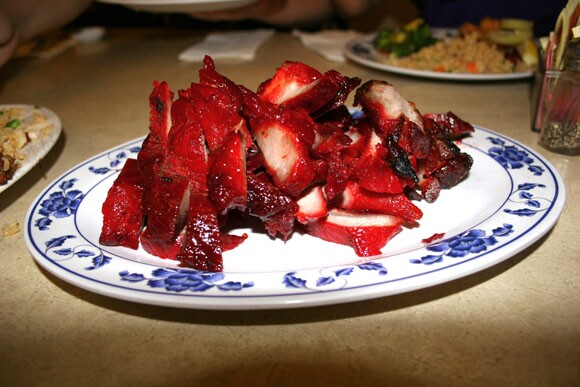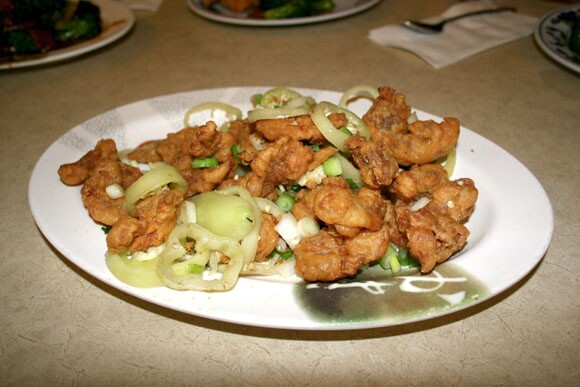Pagoda in the Desert: How Chinese Immigration Shaped the Flavors of the Imperial Valley

At the point of crossing between Calexico, CA and Mexicali, BC, in the southern California desert sits a pagoda. This ancient Chinese architectural statement welcomes visitors to the capital of Baja California, asserting the deep roots of the Chinese community that calls this border city home. It is not uncommon for the collisions of customs at the US/Mexico border to produce hybrid expressions that reflect both Mexico and the United States, but in the Imperial Valley a rich and diverse food culture has been nurtured not just by Mexican and American culinary traditions, but by the large Chinese community that has been a part of the Imperial Valley and Valle de Mexicali for more than one hundred years.
In the 1880s, the Chinese Exclusion Act banned Chinese migrants from entering the U.S., encouraging a great wave of human smuggling from China. Many of these migrants sailed into Mexico and worked their way north settling in Mexicali, a city that borders the Imperial County's southernmost city, Calexico. A second wave of immigrants arrived in Mexicali and the Imperial Valley between 1900 and 1903. Many of these migrant families had been living in Mexico for several years and were drawn by opportunities to work in agriculture. By 1919, Chinese immigrants made up 80% of Mexicali's population. Naturally, immigrants began to experiment with local Mexican ingredients as well as traditional Chinese ingredients creating a unique cuisine specific to the border region.

"[Our recipes] are not the same as in China. Here there are many Mexican families, and we prepare food according to our customers liking. In China, we would not use as much sauce, meat would come on the bone, rice would be different too," Jenissa Zhou explains. In 1984, Jenissa immigrated to San Francisco from the Canton Province of China; there she met her husband Carlos Zhou whose family lived in Mexicali. Together they opened Lucky Chinese Food in 1989. After many expansions, they sold Lucky and now own the Fortune House and Fortune Garden, which have both been included in the Top 100 Chinese Restaurants in the country by the Chinese Restaurant Foundation. "We use between 150 and 200 pounds of rice a day," continues the restaurant owner, "Some of our most popular dishes are Salt and Pepper Fish, Mongolian Beef, and [people] really like Carnitas."

"Carnitas coloradas," a variation of barbecued pork, is an especially delicious result of this experimentation. "Carnitas coloradas," which literally translates to "little red meat," is a tasty little meat dish that takes its name from their intense red coating. To make carnitas coloradas, pork is marinated in a red glaze that includes soy sauce, sugar and frequently ketchup and tequila, and then grilled. Soon after their creation "carnitas coloradas," along with many other experimental Chinese-Mexican dishes pioneered in Mexicali, began to jump the border. Today, this hybrid food, occasionally eaten with a tortilla on the side, and always served with fried rice, or chop suey, is delivered to restaurant tables in the Imperial Valley by Chinese-Mexican waiters who take orders in Spanish with a Chinese accent and may know Chinese better than they do English. The melding of these two food traditions produced an uber-border form of Chinese food that poetically explicates to one's taste buds the necessity, and innumerable benefits of immigration.

A typical meal at a Chinese food restaurant in Mexicali or the Imperial Valley goes something like this: you circle the parking lot outside of the restaurant until you find a spot in the shade. You open your car door, the cool from your air conditioner on at full blast clashes with the triple digit heat radiating from the asphalt that paves the road to the restaurant. You hurry inside. Therein you are welcomed by a lot of Buddhas, dragons, sometimes paper lanterns and ornamentations with Chinese characters. The only trace of Mexico is the glowing neon signs behind bars advertising Mexican beers. You're usually taken to your table by a sweet Asian woman, like Jenissa, she probably owns the restaurant. You take a seat at a table large enough to accommodate the various platters upon which your feast will be served. Food is served in family size portions, each person gets a plate, and then piles of rice, meats, "chiles gueros" (grilled banana peppers), and seafood are brought to the table.
Since portion size depends on how many people are dining in the party, ordering usually requires time and calculation, and ultimately becomes an act of collaboration between the customer and the waiter. Just because there are five people in your party, does not mean you should order dinner for five, which might actually serve 7-8 people depending on the items ordered. You order drinks, often Mexican in origin, Tecate beer, sangria-flavored soda and Mexican-style lemonade made with key limes, cane sugar, and sparkling water, or just a coke. Platters are passed around the table each person taking a bit of whatever he or she would like. A mixture of ketchup and spicy mustard, a Worchester type sauce that some refer to only as "brown sauce," lime juice, or soy sauce may be prepared to complement the meal. Once everyone has finished their meal, leftovers are packed into to-go boxes, and the waiter returns with bilingual fortune cookies printed in English and Spanish. Sometimes instead of a fortune cookie you get just a regular almond cookie; whichever kind it may be, you eat it and head back out into the extreme heat (unless it happens to be winter, then it's freezing outside. Ah, the dichotomies of the desert.).

This amalgam of cultures, and flavors, is the taste of the aesthetics of this particular border community. This too represents the history of relations between Mexico and the U.S. This too represents part of what makes the community unique. More than a food staple and an example of cultural exchange, Chinese food in the Imperial Valley and Mexicali is a longstanding tradition that people of all ethnic and national origins can enjoy. Feasting on Chinese food becomes a common ritual. Lunch after church, a dinner date, and soothing a sore throat with egg-drop soup in winter are all occasions for enjoying a little bit of local comfort food. This is the food that natives offer to new friends, to outsiders visiting for the first time. It is the food eaten during celebrations: weddings, births, graduations from college, and inevitably served at funerals. It is the first thing locals who have moved to Mexico City or New York or Paris eat when visiting home. Restaurants like Dragon or China Town, in Mexicali, or Lucky in El Centro, contain the history of the region in their kitchens, and the formation of culture and community in their dining rooms.
Dig this story? Sign up for our newsletter to get unique arts & culture stories and videos from across Southern California in your inbox. Also, follow Artbound on Facebook, Twitter, and Youtube.
Top Image: Buddha statue at the Fortune House in Mexicali.